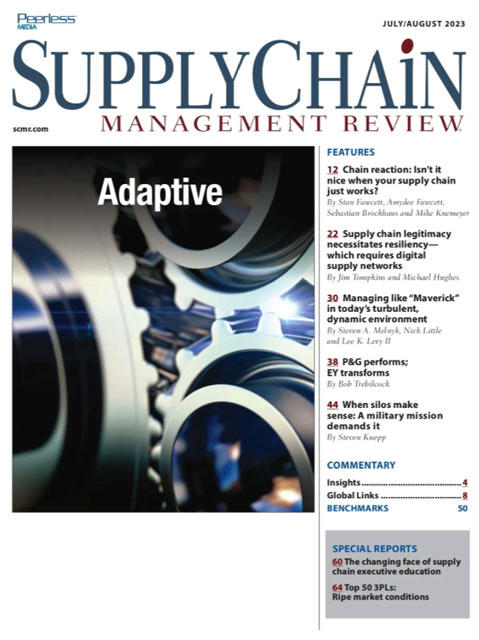Sorry, but your login has failed. Please recheck your login information and resubmit. If your subscription has expired, renew here.
July-August 2023
Most business people have heard the phrase “move fast and break things.” But how do you move fast, break things, and remain profitable? Inside this issue of Supply Chain Management Review are the answers—we hope. We have two articles this month that address decision-making. The articles (“Chain reaction: Isn’t it nice when your supply chain just works?” and “Managing like ‘Maverick’ in today’s turbulent, dynamic environment”) approach the topic of decision-making from decidedly different perspectives, but I believe they are more similar than they appear. Browse this issue archive.Need Help? Contact customer service 847-559-7581 More options
In 1997 I joined Advanced Manufacturing Research, a co-founder of the Supply Chain Council. It was renamed AMR Research (and is now part of Gartner Inc.). I was fortunate enough to be in the right place at the right time because supply chain management (SCM) was growing and fueling the growth of the SCM software industry. This made for a wonderful career for me, tracking and advising about SCM business processes and enabling software.
Dark clouds in cloud computing
While I am no longer in the business of tracking tech companies, I have certainly marveled (from afar) at the growth of the social media companies such as Meta/Facebook and Alphabet/Google, as well as e-commerce giant Amazon.com. But the one software company that really caught my attention has been Salesforce.com, a customer relationship management (CRM) company, focused on supporting marketing, sales, and aftermarket services. Founded in 1999, it has grown much bigger than a typical niche player (vis a vis to a full enterprise suite).
I did not focus on it until this past January when I started reading articles in the Wall Street Journal because Salesforce was announcing that it would be cutting a significant amount of its workforce. The following titles were
several of them.
- “Salesforce’s Business Model Faces Test” (Jan. 24, 2023)
- “New Salesforce Has to Keep Selling” (Feb. 28, 2023)
- “Salesforce Profit Goals Focus on Efficiencies” (March 8, 2023)
It sells subscription-based “software to mid-size-to-large companies, [and] has always run at a high cost compared with its peers.” Wall Street rewarded the company with increasing stock prices because of its rapid growth with little regard to profitability. The founder ran it like a family-oriented lifestyle business and did not prepare it for a time when the growth would slow. I’ve had experience with subscription-based businesses. A lesson I learned is that when as you grow a business—for example at 25% a year, such as Salesforce—continuing to grow subscribers at a double-digit percent rate eventually becomes very hard to achieve.
Other cloud computing-based businesses have been experiencing a similar plight. A WSJ article (March 21, 2023) was titled “Amazon Extends Layoffs to Cloud, Ad Businesses.” The next month another article was written, “Amazon Rebounds, But Woes Hit Cloud” (April 28, 2023). In its highly profitable cloud division, AWS (Amazon Web Services), it saw “signs of cooling.” Meanwhile, Microsoft woes were reported in “Microsoft Growth Is Muted as Cloud Cools Off” (April 26, 2023). In addition to these companies, Meta and Alphabet were also downsizing.

This complete article is available to subscribers only.
Log in now for full access or start your PLUS+ subscription for instant access.
SC
MR
Sorry, but your login has failed. Please recheck your login information and resubmit. If your subscription has expired, renew here.
July-August 2023
Most business people have heard the phrase “move fast and break things.” But how do you move fast, break things, and remain profitable? Inside this issue of Supply Chain Management Review are the answers—we… Browse this issue archive. Access your online digital edition. Download a PDF file of the July-August 2023 issue.In 1997 I joined Advanced Manufacturing Research, a co-founder of the Supply Chain Council. It was renamed AMR Research (and is now part of Gartner Inc.). I was fortunate enough to be in the right place at the right time because supply chain management (SCM) was growing and fueling the growth of the SCM software industry. This made for a wonderful career for me, tracking and advising about SCM business processes and enabling software.
Dark clouds in cloud computing
While I am no longer in the business of tracking tech companies, I have certainly marveled (from afar) at the growth of the social media companies such as Meta/Facebook and Alphabet/Google, as well as e-commerce giant Amazon.com. But the one software company that really caught my attention has been Salesforce.com, a customer relationship management (CRM) company, focused on supporting marketing, sales, and aftermarket services. Founded in 1999, it has grown much bigger than a typical niche player (vis a vis to a full enterprise suite).
I did not focus on it until this past January when I started reading articles in the Wall Street Journal because Salesforce was announcing that it would be cutting a significant amount of its workforce. The following titles were several of them.
- “Salesforce’s Business Model Faces Test” (Jan. 24, 2023)
- “New Salesforce Has to Keep Selling” (Feb. 28, 2023)
- “Salesforce Profit Goals Focus on Efficiencies” (March 8, 2023)
It sells subscription-based “software to mid-size-to-large companies, [and] has always run at a high cost compared with its peers.” Wall Street rewarded the company with increasing stock prices because of its rapid growth with little regard to profitability. The founder ran it like a family-oriented lifestyle business and did not prepare it for a time when the growth would slow. I’ve had experience with subscription-based businesses. A lesson I learned is that when as you grow a business—for example at 25% a year, such as Salesforce—continuing to grow subscribers at a double-digit percent rate eventually becomes very hard to achieve.
Other cloud computing-based businesses have been experiencing a similar plight. A WSJ article (March 21, 2023) was titled “Amazon Extends Layoffs to Cloud, Ad Businesses.” The next month another article was written, “Amazon Rebounds, But Woes Hit Cloud” (April 28, 2023). In its highly profitable cloud division, AWS (Amazon Web Services), it saw “signs of cooling.” Meanwhile, Microsoft woes were reported in “Microsoft Growth Is Muted as Cloud Cools Off” (April 26, 2023). In addition to these companies, Meta and Alphabet were also downsizing.
 SUBSCRIBERS: Click here to download PDF of the full article.
SUBSCRIBERS: Click here to download PDF of the full article.
SC
MR


More Cloud
- How technological innovation is paving the way for a carbon-free future in logistics and supply chains
- The art of winning at supply chain technology: Lessons from managing tech for the largest private trucking fleet in the U.S.
- The 3 types of cyberattacks affecting global supply chains
- NextGen Supply Chain Conference set for October 21-23
- How to identify and eliminate internal demons in supply chain management
- How industrial leaders can avoid buyer’s remorse when investing in new technology
- More Cloud
Latest Podcast

 Explore
Explore
Software & Technology News
- How technological innovation is paving the way for a carbon-free future in logistics and supply chains
- Körber Supply Chain Software’s Craig Moore says MercuryGate acquisition is about the customer
- Robotic use grows by 10%
- Harnessing Edge Computing and AI Vision Systems for Real-Time Logistics Insights
- The art of winning at supply chain technology: Lessons from managing tech for the largest private trucking fleet in the U.S.
- The 3 types of cyberattacks affecting global supply chains
- More Software & Technology
Latest Software & Technology Resources

Subscribe

Supply Chain Management Review delivers the best industry content.

Editors’ Picks





